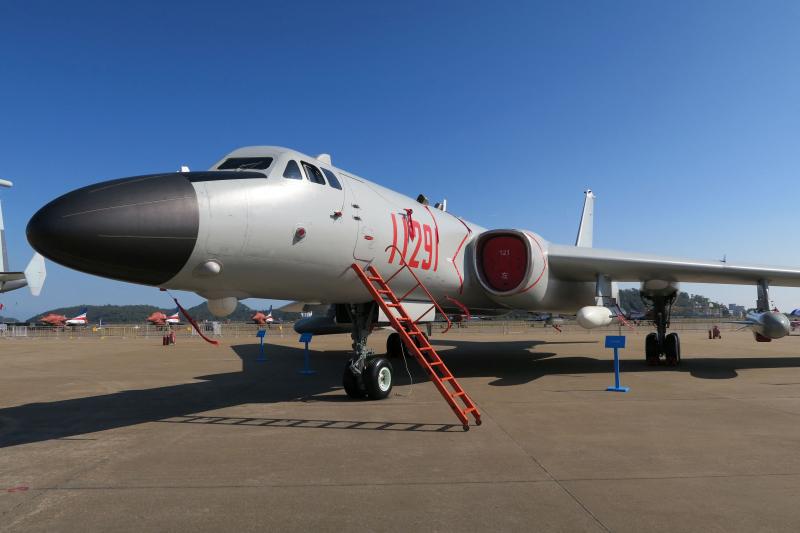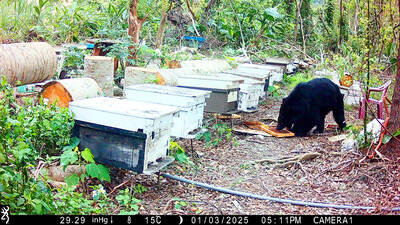In a series of war games in the seas and skies around Taiwan last month, China deployed some of its newest strike aircraft, warships and missile forces.
One of the most menacing weapons used in the drills: an updated version of a bomber that first flew in the early years of the Cold War.
Like the US, which still relies on upgraded versions of the B-52, a bomber from the same era, China has successfully modernized its jet-powered H-6 to carry on flying deep into the 21st century.

Photo: Reuters
These bombers were shown on China’s state-controlled media taking off for missions designed to intimidate Taiwan as part of the war-game drills.
Dubbed “Joint-Sword 2024B” by China’s military, the maneuvers were a “stern warning” to people in Taiwan seeking independence, the Chinese military said.
Taiwan’s Ministry of National Defense reported that 153 Chinese military aircraft, 14 naval vessels and 12 other ships were detected around the nation over a 25-hour period after the start of the exercise on Oct. 14.
The ministry also reported that 111 of the aircraft had crossed the median line of the Taiwan Strait and entered the nation’s air defense identification zone.
The ministry told Reuters that “three groups of three H-6 aircraft” had been detected operating in the nation’s airspace during China’s military exercise.
Two of the groups “conducted simulated attack drills,” the ministry said.
China’s Ministry of National Defense did not respond to questions for this story.
Some modernized versions of China’s H-6 bomber are now capable of launching ballistic missiles armed with nuclear warheads, while others can carry multiple long-range anti-ship and land attack missiles, according to defense analysts and Pentagon reports on the Chinese military.
Some versions can be refueled in flight, allowing them to fly from bases on the Chinese mainland and strike at targets deep into the Western Pacific, where the US has large bases on Guam and elsewhere.
Asked about the military drills, Taiwan’s defense ministry said the nation was using “joint intelligence surveillance to keep track of the communist military's movements around Taiwan,” while also dispatching “air, sea and missile forces to respond as appropriate to ensure national defense and security.”
Pentagon spokesperson Major Pete Nguyen said the US was “prepared to respond to any threat and protect the homeland.”
US Secretary of Defense Lloyd Austin “has often said that he does not believe conflict with the PRC [People’s Republic of China] is imminent nor inevitable,” Nguyen said in response to questions.
Unlike the US, which stopped building the B-52 in 1962, China has continued to make the twin-engine H-6 at a plant in central China.
However, H-6 production may have recently slowed or been halted, according to Thomas Shugart, a former US Navy submarine officer and an expert on China’s military.
He estimates the Chinese air force now has about 230 of these bombers.
The H-6 is derived from the Tupolev Tu-16 bomber, which the Soviet Union introduced into service in the early 1950s and was given the NATO code name Badger.
China began building these aircraft under license in the late 1950s, according to experts on the Chinese People’s Liberation Army.
The Taiwanese and Japanese militaries have reported that H-6 bombers have been frequently deployed on flights near their airspace in recent years.
They are also sent on flights over the South China Sea, where Beijing claims sovereignty over extensive areas of disputed territory.
In a conflict, these bombers would pose a serious threat to ships and targets on land, US and Taiwanese military experts say.
Shugart said that Chinese military doctrine for island landing campaigns, such as an invasion of Taiwan, calls for strikes against headquarters, communications facilities, logistics centers and other key targets, along with attacks on airfields, ports and ships at sea.
“I would expect H-6s to be involved in all of these sorts of operations,” he said.
These attacks would likely be coordinated with missile strikes, possibly without warning, that would soften air defenses and crater runways to trap aircraft on the ground, Shugart added.
He said these aircraft could then be hit with cruise missiles launched from H-6 bombers.
China’s official media in mid-September provided some insight into the role the H-6 might play in a clash off the Chinese coast.
State broadcaster CCTV showed footage of one of these bombers flying in an exercise with fighters and a long-range WZ-7 surveillance drone.
The drone penetrated the air defenses of a potential adversary, identified a target and relayed this information to the H-6, according to the footage.
The bomber was shown launching an anti-ship missile.
Experts say the US should try to neutralize the H-6 bombers while they are still on the ground.
“Any common sense war plan would target those aircraft before they could take off,” said David Deptula, dean of the Washington-based Mitchell Institute for Aerospace Studies and a retired US Air Force lieutenant general.
In March testimony to the US-China Economic and Security Review Commission, Shugart said that China’s H-6 force has expanded and these aircraft now have improved airframes, technology, engines and long-range weapons.
While regularly sending the H-6 on missions off the Chinese coast, Beijing is now deploying these aircraft in the same way the US Air Force uses long-range patrols of the B-52 and its other bombers to signal its ability to strike at distant targets.
On July 24, US and Canadian fighter jets scrambled to intercept a joint patrol of two Chinese H-6 and two Russian Tu-95 bombers near Alaska, according to a statement from the North American Aerospace Defense Command (NORAD).
While the Russians conduct regular patrols in this area, it was the first time Chinese bombers had flown close to the US mainland in an operation that revealed the growing power and confidence of China’s military, former US air force officers said.
The flights were not seen “as a threat, and NORAD continues to monitor competitor activity near North America and meet presence with presence,” Nguyen said.
The Chinese and Russian defense ministries did not respond to a request for comment.
A spokesman for China’s Ministry of National Defense, Senior Colonel Zhang Xiaogang (張曉剛), told a news conference at the time that the joint patrol was to test and improve coordination between the Chinese and Russian air forces.
“This operation does not target any third party,” Zhang said.

HORROR STORIES: One victim recounted not realizing they had been stabbed and seeing people bleeding, while another recalled breaking down in tears after fleeing A man on Friday died after he tried to fight the knife-wielding suspect who went on a stabbing spree near two of Taipei’s busiest metro stations, Taipei Mayor Chiang Wan-an (蔣萬安) said. The 57-year-old man, identified by his family name, Yu (余), encountered the suspect at Exit M7 of Taipei Main Station and immediately tried to stop him, but was fatally wounded and later died, Chiang said, calling the incident “heartbreaking.” Yu’s family would receive at least NT$5 million (US$158,584) in compensation through the Taipei Rapid Transit Corp’s (TRTC) insurance coverage, he said after convening an emergency security response meeting yesterday morning. National

Taiwan has overtaken South Korea this year in per capita income for the first time in 23 years, IMF data showed. Per capita income is a nation’s GDP divided by the total population, used to compare average wealth levels across countries. Taiwan also beat Japan this year on per capita income, after surpassing it for the first time last year, US magazine Newsweek reported yesterday. Across Asia, Taiwan ranked fourth for per capita income at US$37,827 this year due to sustained economic growth, the report said. In the top three spots were Singapore, Macau and Hong Kong, it said. South

PLANNED: The suspect visited the crime scene before the killings, seeking information on how to access the roof, and had extensively researched a 2014 stabbing incident The suspect in a stabbing attack that killed three people and injured 11 in Taipei on Friday had planned the assault and set fires at other locations earlier in the day, law enforcement officials said yesterday. National Police Agency (NPA) Director-General Chang Jung-hsin (張榮興) said the suspect, a 27-year-old man named Chang Wen (張文), began the attacks at 3:40pm, first setting off smoke bombs on a road, damaging cars and motorbikes. Earlier, Chang Wen set fire to a rental room where he was staying on Gongyuan Road in Zhongzheng District (中正), Chang Jung-hsin said. The suspect later threw smoke grenades near two exits

The Forestry and Nature Conservation Agency yesterday launched a gift box to market honey “certified by a Formosan black bear” in appreciation of a beekeeper’s amicable interaction with a honey-thieving bear. Beekeeper Chih Ming-chen (池明鎮) in January inspected his bee farm in Hualien County’s Jhuosi Township (卓溪) and found that more than 20 beehives had been destroyed and many hives were eaten, with bear droppings and paw prints near the destroyed hives, the agency said. Chih returned to the farm to move the remaining beehives away that evening when he encountered a Formosan black bear only 20m away, the agency said. The bear